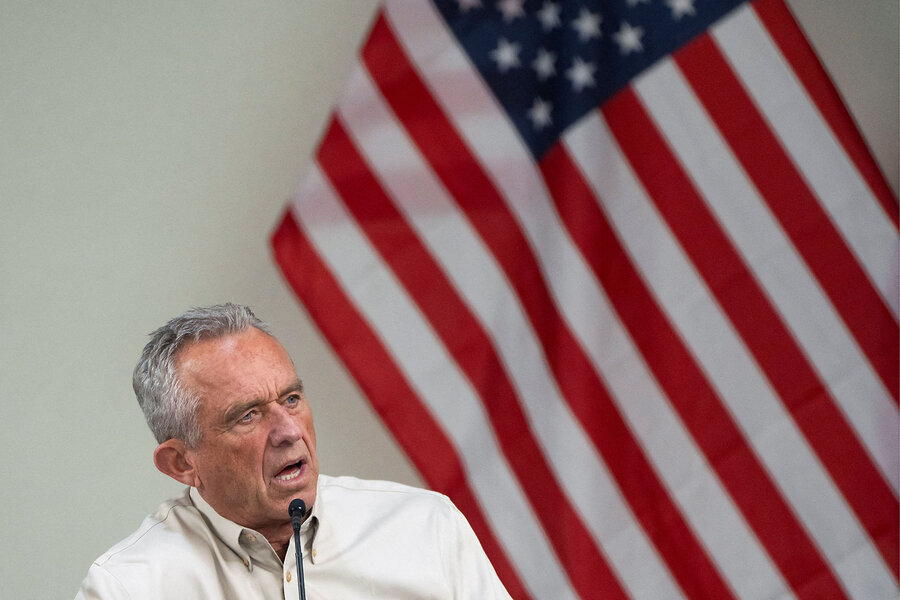RFK Jr. is popular, but he’s probably not going to win. Here’s why.
Loading...
More Americans identify as independents (42%) than as Democrats (30%) or Republicans (28%). And as the two major parties coalesce around their prospective nominees, President Joe Biden and former President Donald Trump, a majority of voters say they would like a third choice.
Independent candidate Robert F. Kennedy Jr. is riding that wave of discontent, averaging 15% support in national polls. The group No Labels is also pressing ahead with plans to field a “unity ticket.” Others running outside the two-party system include the Green Party’s Jill Stein and independent Cornel West.
Why We Wrote This
Many voters say they want an alternative to President Joe Biden and former President Donald Trump. But independent and third-party candidates face huge structural hurdles – from ballot access to the Electoral College.
Yet those mounting third-party bids for the White House face daunting hurdles, including complex rules governing ballot access and a winner-take-all electoral system that gives voters a strong incentive not to “waste” their ballot on a long-shot contender.
The independent presidential candidate with the highest vote share in more than a century, Texas billionaire Ross Perot, won 19% of the popular vote in 1992, yet failed to win a single state.
“It’s not as though we banned third parties. They’re allowed,” says Scot Schraufnagel, a political scientist at Northern Illinois University. “But it’s really tough for them to get any traction under the current election law.”
More Americans identify as independents (42%) than as Democrats (30%) or Republicans (28%). And as the two major parties coalesce around their prospective nominees, President Joe Biden and former President Donald Trump, a majority of voters say they would like a third choice.
Independent candidate Robert F. Kennedy Jr. is riding that wave of discontent, averaging 15% support in national polls. The group No Labels is also pressing ahead with plans to field a “unity ticket” that it says will provide voters with a “moderate” choice. Other candidates running outside the two-party system include the Green Party’s Jill Stein and independent Cornel West.
Yet those mounting third-party bids for the White House face daunting hurdles. They must navigate a complex labyrinth of rules governing ballot access and a winner-take-all electoral system that gives voters a strong incentive not to “waste” their ballot on a long-shot contender.
Why We Wrote This
Many voters say they want an alternative to President Joe Biden and former President Donald Trump. But independent and third-party candidates face huge structural hurdles – from ballot access to the Electoral College.
The independent presidential candidate with the highest vote share in more than a century, Texas billionaire Ross Perot, won 19% of the popular vote against Bill Clinton and George H.W. Bush in 1992, yet failed to win a single state.
“It’s not as though we banned third parties. They’re allowed,” says Scot Schraufnagel, a political scientist at Northern Illinois University. “But it’s really tough for them to get any traction under the current election law.”
What are the barriers to ballot access?
Any path to the White House hinges on ballot access, and each state makes its own rules. The deadlines for qualifying also vary by state, and a few have already passed.
In Alabama, for instance, any political party that receives 20% of the vote in a previous election automatically qualifies for the ballot. Others need to collect signatures – at least 3% of the number of voters in the state’s previous gubernatorial election.
Alaska gives ballot access to any political party whose candidate for governor in the previous general election won at least 3% of the popular vote. Independent candidates need to collect signatures that total at least 1% of the number of voters in the most recent presidential election.
In Michigan, new political parties need signatures of qualified, registered electors totaling at least 1% of the number of votes cast in the most recent gubernatorial election, with at least 100 signatures each from half of the state’s congressional districts.
The patchwork of rules and regulations requires different strategies in different states, says Daron Shaw, a political scientist at the University of Texas at Austin. “That’s a problem for less well-funded, less well-organized, less institutionally established political movements.”
Mr. Kennedy is pursuing different tactics to try to gain ballot access. He’s running as an independent in states that require fewer signatures for unaffiliated candidates. In states that make it easier for those with party affiliations, supporters have formed a party called We the People. The party is on the ballot in Hawaii, and Mr. Kennedy is listed as an unaffiliated candidate on Utah’s ballot. The Kennedy campaign said this week that it also has enough signatures to qualify in Nevada and New Hampshire. A super PAC called American Values 2024 is working on his behalf in at least a dozen states, and it claims to have enough signatures to get him onto ballots in Georgia, Arizona, Michigan, and South Carolina.
Many states require independent candidates to name their running mate when filing papers to get on the ballot. Mr. Kennedy announced at the end of March his pick for vice president: attorney and tech entrepreneur Nicole Shanahan, from Northern California.
No Labels has vowed that it will make it onto the ballot in all 50 states and says it has secured spots in 17 states so far, although the party has yet to announce candidates. As of this week, the Green Party lists 20 states plus the District of Columbia as “on ballot.”
What other hurdles do independent candidates face?
Once a candidate makes it onto the ballot, Duverger’s law kicks in. Winning the U.S. presidency actually comes down to winning individual states, most of which are winner-take-all. French political scientist Maurice Duverger concluded in the 1950s that this system results in two-party dominance. Voters become reluctant to cast ballots for minor-party candidates they see as having no chance of actually winning, preferring to throw their support to one of the two major parties.
If the dominant parties fracture, there could be an opening for a new one. In the 1850s, as America drew closer to civil war, the Republican Party was formed as an anti-slavery coalition and eventually replaced the Whigs as the primary political opposition to the Democrats. In 1860, Republican Abraham Lincoln won the presidency in a four-way race with less than 40% of the popular vote.
Today, third-party candidates are most often considered “spoilers.” In a close election – and U.S. presidential elections in recent years have generally been quite close – any votes siphoned away from the two major parties can be seen as the difference between a narrow win and a narrow loss.
In 2000, many Democrats faulted Green Party candidate Ralph Nader for taking key votes away from Vice President Al Gore in Florida, which Mr. Gore wound up losing by 537 votes. In 2016, when Democratic nominee Hillary Clinton narrowly lost to Donald Trump despite winning the popular vote, some Democrats argued that Green Party candidate Jill Stein may have shifted just enough votes in key states away from Mrs. Clinton to put Mr. Trump in the White House.
It’s impossible to know definitively whether voters who cast ballots for third-party contenders would have backed one of the major-party nominees instead – or simply stayed home. But this year, Democrats appear to be taking the threat more seriously, forming a dedicated team at the Democratic National Committee and a coalition of outside groups to hit back at third-party campaigns on both political and legal fronts.
How does the Electoral College fit in?
The Electoral College creates a huge hurdle for third-party candidates. Forty-eight states (all but Maine and Nebraska) award all of their electoral votes to the candidate who wins a plurality of the popular vote.
Mr. Perot’s 1992 bid demonstrated how even strong third-party showings can be stymied by the Electoral College. He achieved ballot access in all 50 states, funded by his own personal wealth and fueled by a powerful grassroots movement collecting signatures on his behalf. In the end, he won nearly one-fifth of the popular vote, a rare achievement for an independent candidate. But he received zero Electoral College votes.
Many Americans now say the system needs to change. A Pew Research poll from a few months ago shows nearly two-thirds of voters believe the popular vote alone should determine the presidency.
“The interest in a third-party candidate seems pretty substantial,” says Dr. Shaw. But that attraction is often offset by the power of negative polarization, in which voters are motivated to cast ballots for one major-party candidate largely out of strong opposition to the other. “Whatever antipathy there is to the major-party candidates seems to be overwhelmed by the fear, the anger about the other side winning.”
But even if they don’t win, third-party candidates can have real influence on the national conversation. Mr. Perot made the budget deficit a central issue of his campaign in 1992. The following year, Congress passed a deficit reduction bill.
“Third parties are a source of energy; they’re a source of policy innovation,” says Dr. Shaw. The candidates themselves may fall short, but their ideas often wind up being co-opted by the major parties. “So that’s an important part of the process.”
Editor’s note: this story has been updated to reflect evolving campaign events, and to correct information related to the 2000 presidential race.










